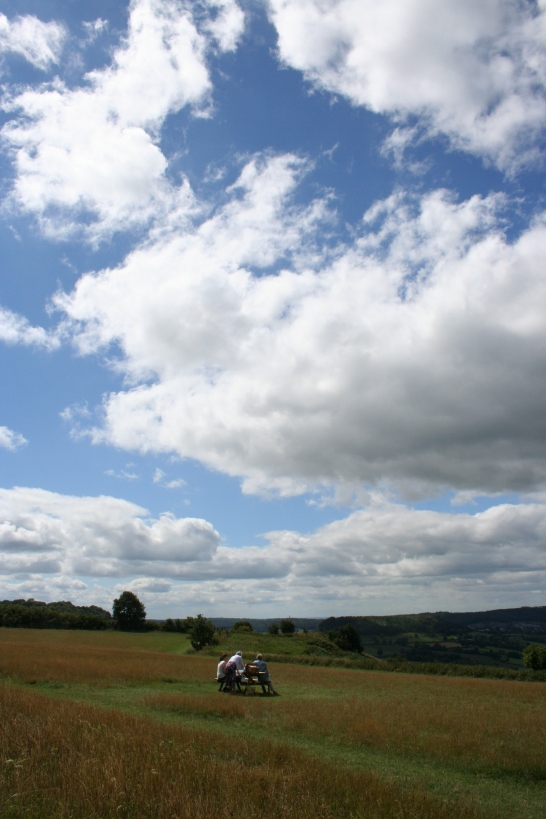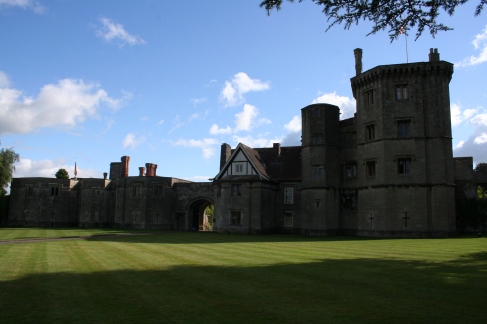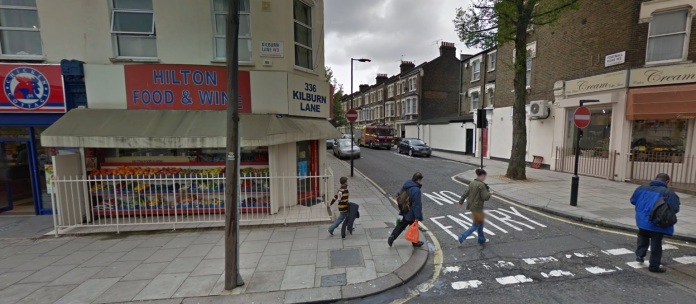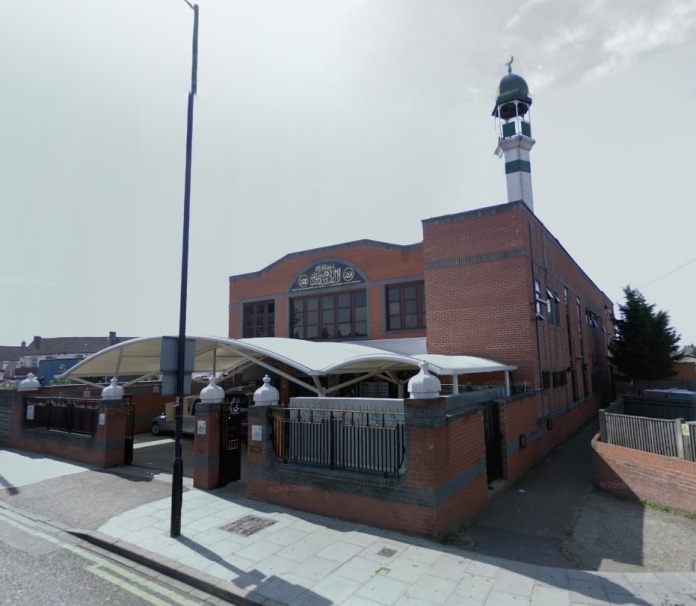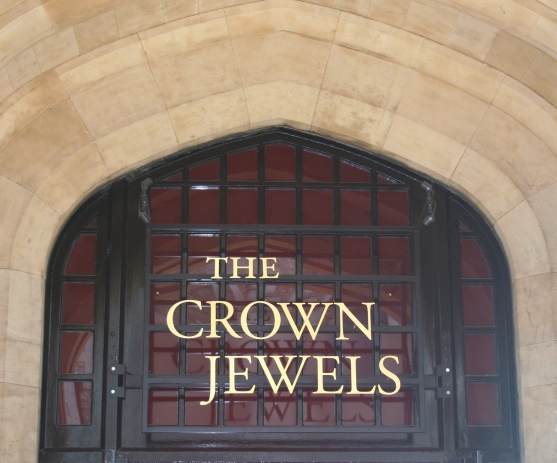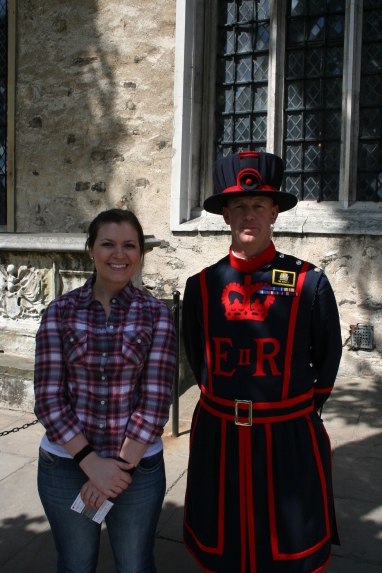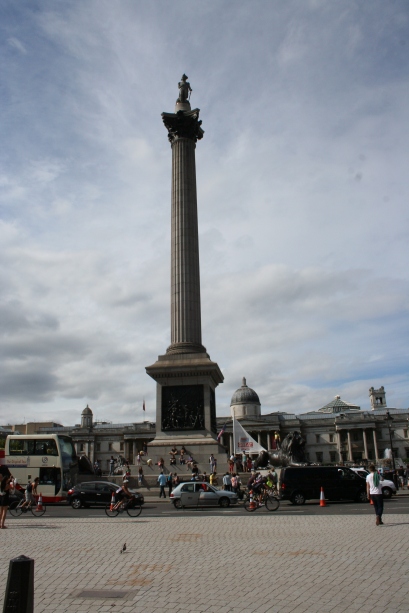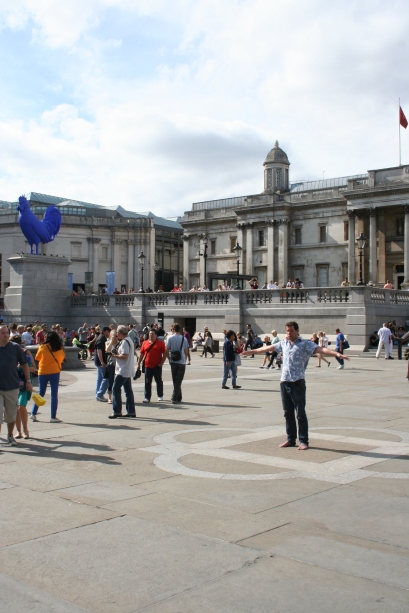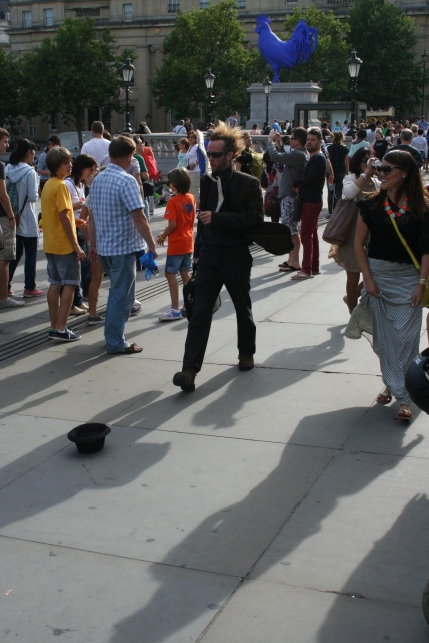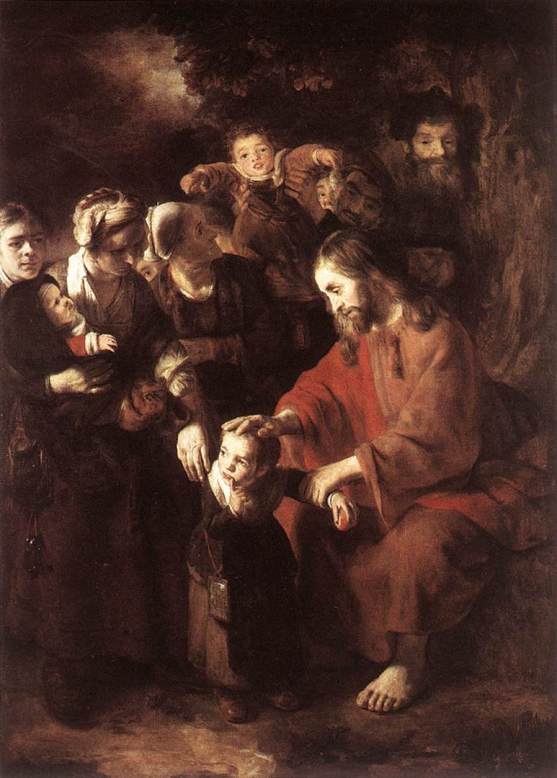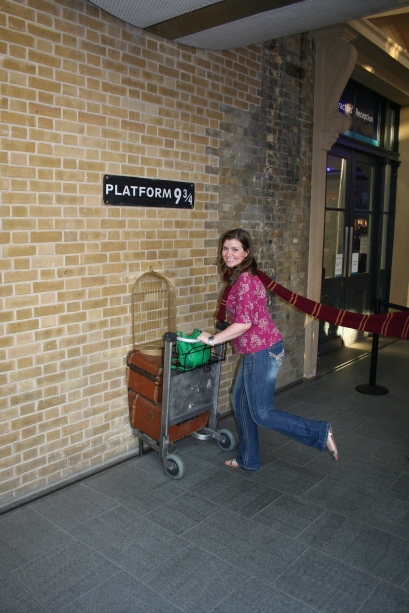Two days ago, we visited Spurgeon’s College, a Baptist seminary in South London originally founded by Charles Haddon Spurgeon. Steve Latham, a kind, patient minister of the Word and member of the college faculty, was giving us a tour of the facilities when he mentioned that he’d like to show us the “Spurgeon Heritage Room,” but he’d have to get the key first.
You see, it was locked, as you might lock your attic.
Before making our way up the stairs to the small, dusty room filled with original Spurgeon memorabilia (as in handwritten letters and personal Bibles), we passed by a pulpit. Steve mentioned in passing that it was the preaching from this pulpit that had converted Spurgeon. I touched it in disbelief.
There were no lines, no ticket for admission, no overpriced guidebooks or gift shops. Just the lonely echoes of a life given in service to Christ.
I discovered a similar situation when Laura and I visited Wesley’s Chapel in Central London today. Upon excitedly entering the cast iron gates of the courtyard in front of the chapel, I became immediately aware that this space held little more significance for the locals than as a quiet place where busy Londoners could have a peaceful lunch on one of the benches. This is not an indictment, only an observation. I know that I do this as well, on a deeper, more dangerous level (avoiding the sacred space of time alone with the Father, but acting as if time spent making money is so important). But, oh, what a joy to be at my elder brother’s old chapel.

Perhaps it is a reaction against the rise of megachurches in the States, but I have a special place in my heart for smaller spaces of worship. It could also be my growing awareness over the last few days that the English are content with a smaller scale by which to measure things, especially when compared to the American obsession with size (for instance, there are only six-packs of soda – or fizzy juice – in the grocery stores here, whereas Walmarts back home have one size: 24-packs). Maybe this is due to some subconscious impact made on our psyches by the difference in the land masses we inhabit (although we’ve both had a thing for expanding our respective empires). Regardless, Wesley’s Chapel stole my heart.

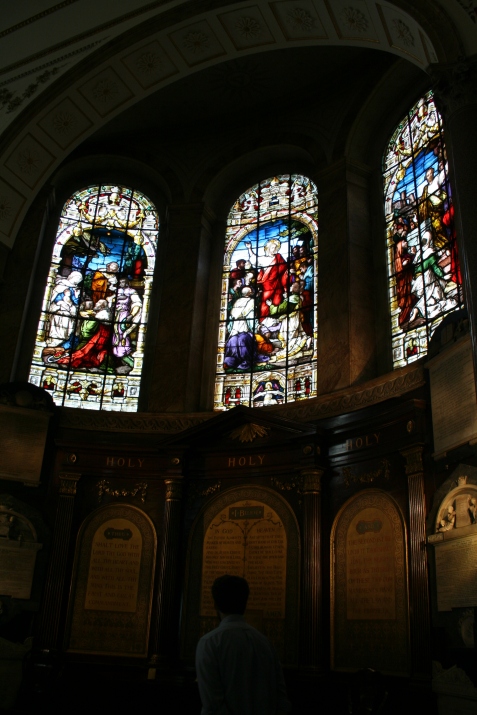
A closer look before the Lord’s table…
These two stained glass windows greeted us in the foyer – absolutely stunning.

The writing on the glass reads: “Let it be known this day that thou art God in Israel. The God that answers by fire, let him be God” (1 Kings 18:24, 36); “To the glory of God and in memory of the Rev. George H. McNeal”

The banner above the soldier reads, “His strength is as the strength of ten because his heart is true.” The lions underneath surround a chalice labeled, “Holy Grail.” The soldier stands on top of his enemies who are identified as “Envy, Jealousy, Greed, Falsehood, and Malice.”
A poem underneath reads:
“Bring me my bow of burning cold
Bring me my arrows of desire
Bring me my spear of clouds unfold
Bring me my chariot of fire
I will not cease from mental fight
Nor shall my sword sleep in my hand
Till we have built Jerusalem
In England’s green and pleasant land”
The dedication underneath reads, “To the glory of God and in loving memory of William Blackburn Fitzgerald. This window is dedicated by his guild comrades, June 22nd 1932. Founder of the Wesley Guild and its first secretary.”
How strange and marvelous and slightly sad to then visit Rev. Wesley’s grave.

A humble grave for a humble man; he was not one for needless flamboyance. A member of the Methodism Museum’s staff informed us that Wesley abstained from drinking tea because he felt it was a stimulant and a waste of money. He gave his life to the service of God; in death, he could not be parted far from the chapel where he served.

Among other things, this eulogy proclaims,
“After having languished a few Days, He at length finished his course and his life together, gloriously triumphing over death March 2nd An. Dom. 1791 in the Eighty-eighth Year of his Age.”
“The best of all,” Wesley reportedly stated before triumphing over death, “is God is with us.” The nearby museum possessed evidence of a near-fanatical devotion for Wesley among his followers after his death (numerous locks of Wesley’s hair were found preserved in various forms), but the man himself understood that the greatest gift is Immanuel, “God with us.” Laura and I stood in the prayer closet that Wesley would visit at 4:00 AM every morning before gathering all the members of his household for morning prayer at the chapel at 5:00 AM.
Earlier I mentioned the pulpit marking the occasion of Spurgeon’s conversion. I also came upon another significant pulpit: the one Wesley preached from.
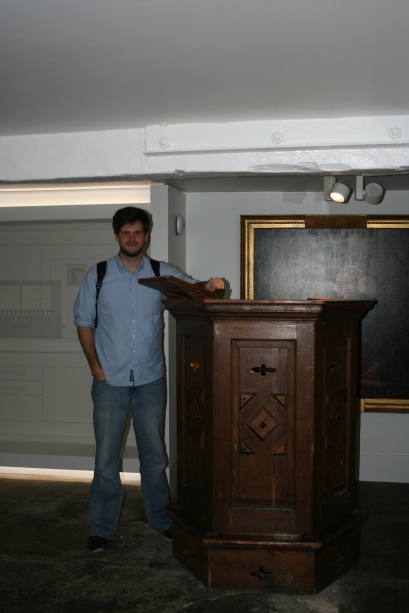
Laura suggested I stand in the pulpit for the picture, which I refused, feeling it would be both sacrilegious and destructive to the structural integrity of the 300 year-old relic.
We were also given the incredible privilege of touring Wesley’s final home, directly adjacent to the chapel. A kind, older English woman gave us a surprisingly informative and in-depth tour of the place. Although most of the exhibits could not be photographed for fear that the flash would damage the fabric, paintings, etc., we were able to see Wesley’s old preaching gown, hat, shoes, and cane (the saint did not wear one of the wigs customary for his era, feeling that it also was a waste of money that could be given to the poor). We also saw this magnificent, familiar portrait:

It should be mentioned that this is not believed to be as close an actual likeness to Wesley as is captured by other paintings, such as the following, which Wesley approved of personally (and we were also able to behold – it was on loan from the National Portrait Gallery):

This portrait can be seen in the next photograph, as well as Wesley’s personal study chair, where – as the guide explained to us – he could sit in the conventional fashion or sit backwards, facing the desk on the back (I think someone should contact Ikea with the details).

Also visible in this picture is Samuel Wesley’s (John’s father) French grandfather clock, dating from the 17th century and still ticking.
The guide also informed us that Wesley, while traveling on his preaching circuit by horseback, would not only often read on his travels, but even do some writing. We saw the writing desk he used for this purpose. Apparently he would ride the horse backwards, placing the desk on the horse’s rump. Incredible.
Laura and I sat in one of the chapel’s pews (nearly as old as our homeland – the chapel was established in 1779), and thanked God for his servant, John Wesley, and the kingdom work accomplished through him.
“Therefore, since we are surrounded by so great a cloud of witnesses, let us also lay aside every weight, and sin which clings so closely, and let us run with endurance the race that is set before us, looking to Jesus, the founder and perfecter of our faith, who for the joy that was set before him endured the cross, despising the shame, and is seated at the right hand of the throne of God.“ (Hebrews 12:1-2)
We left this holy place to visit an earthly palace, enshrining a different throne, one belonging to Queen Elizabeth II.
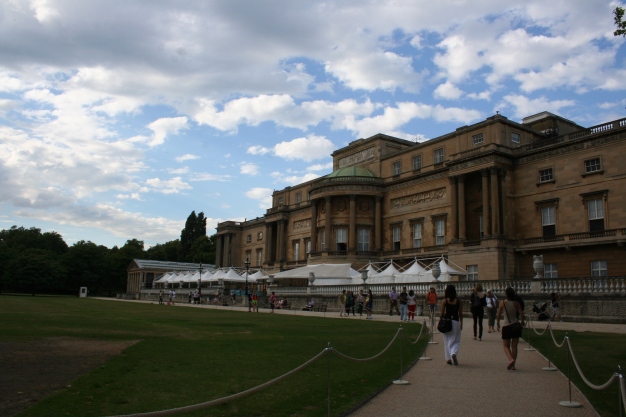
The view of the back of the palace after finishing the tour.

The Palace Gardens; also, Laura informs me, the sight of the reception for the wedding of Prince William and his bride, Kate, the Duchess of Cambridge.
We were allowed absolutely no photographs inside (and we were politely informed by signage, more than once, that our movements were being surveilled), but I can tell you that it was quite breathtaking to behold George IV’s art collection, where I saw one of the original self-portraits of Rembrandt van Rijn.

We ended the evening with some excellent (though overpriced; I’m beginning to see a pattern in London) lamb curry and rice at a local Indian restaurant, Delhi Brasserie. Tomorrow, Lord willing, will bring the Tower of London and a celebration of the Eucharist at St. Paul’s, among other things. I will end with a prayer by John Wesley, handed out to us by our tour guide as we stood in Wesley’s old prayer closet. May it also be mine and yours.
The Covenant
I am no longer my own, but thine.
Put me to what thou wilt, rank me with whom thou wilt.
Put me to doing, put me to suffering.
Let me be employed for thee or laid aside for thee,
exalted for thee or brought low for thee.
Let me be full, let me be empty.
Let me have all things, let me have nothing.
I freely and heartily yield all things to thy pleasure and disposal.
And now, O glorious and blessed God, Father, Son and Holy Spirit,
thou art mine, and I am thine.
So be it.
And the covenant which I have made on earth,
let it be ratified in heaven.
Amen.
What do we have if we don’t have Him?
The peace of our Lord,
Daniel

